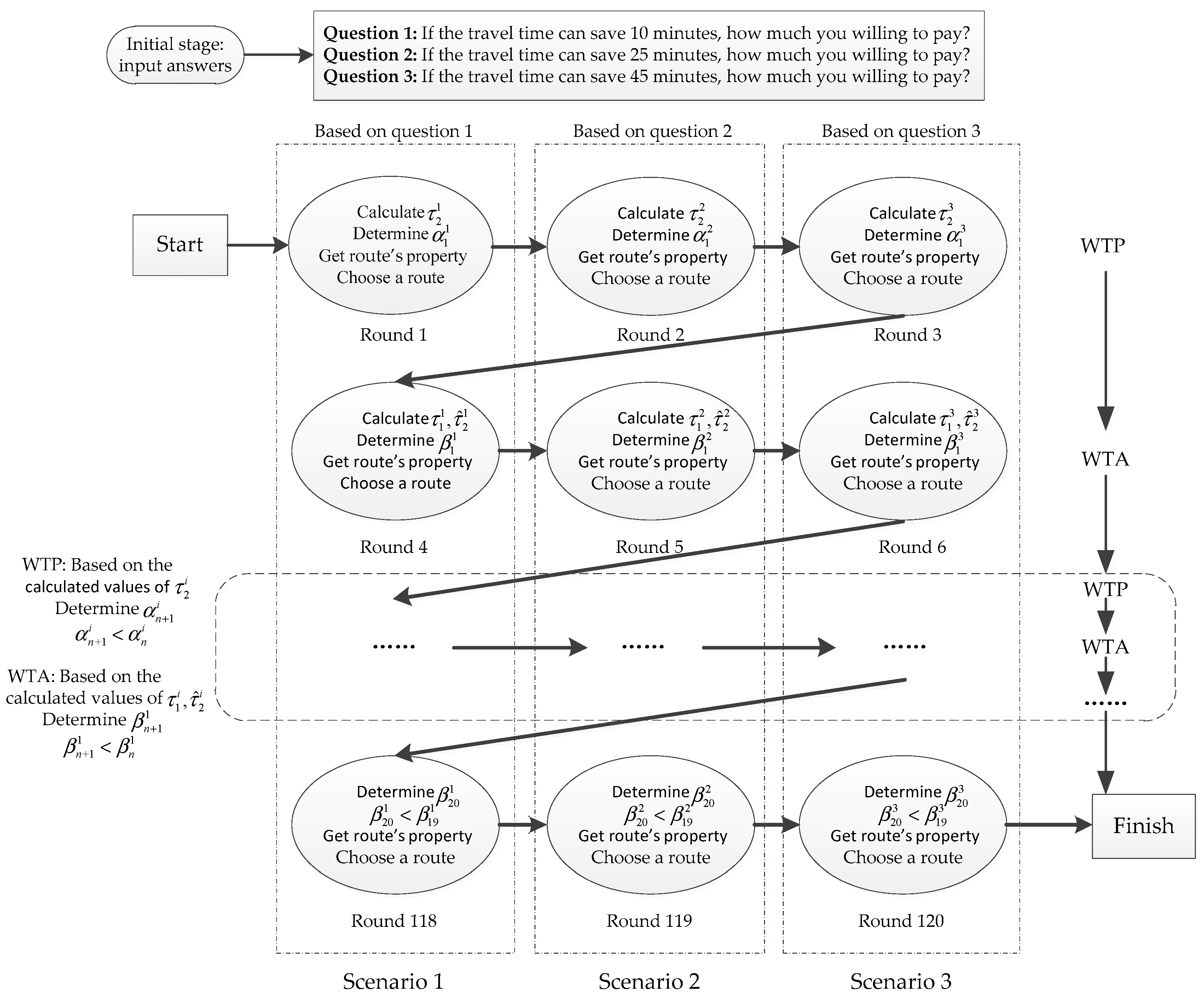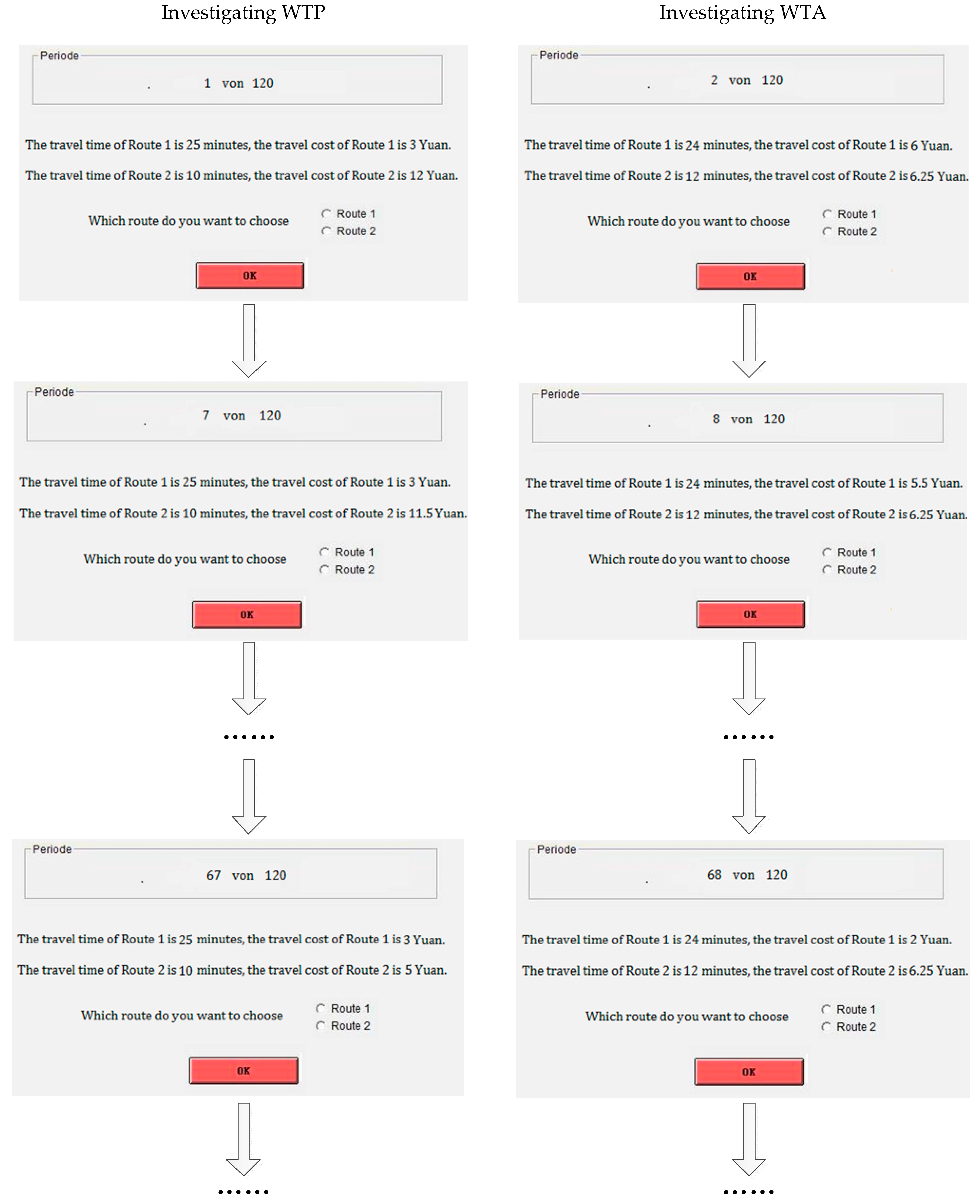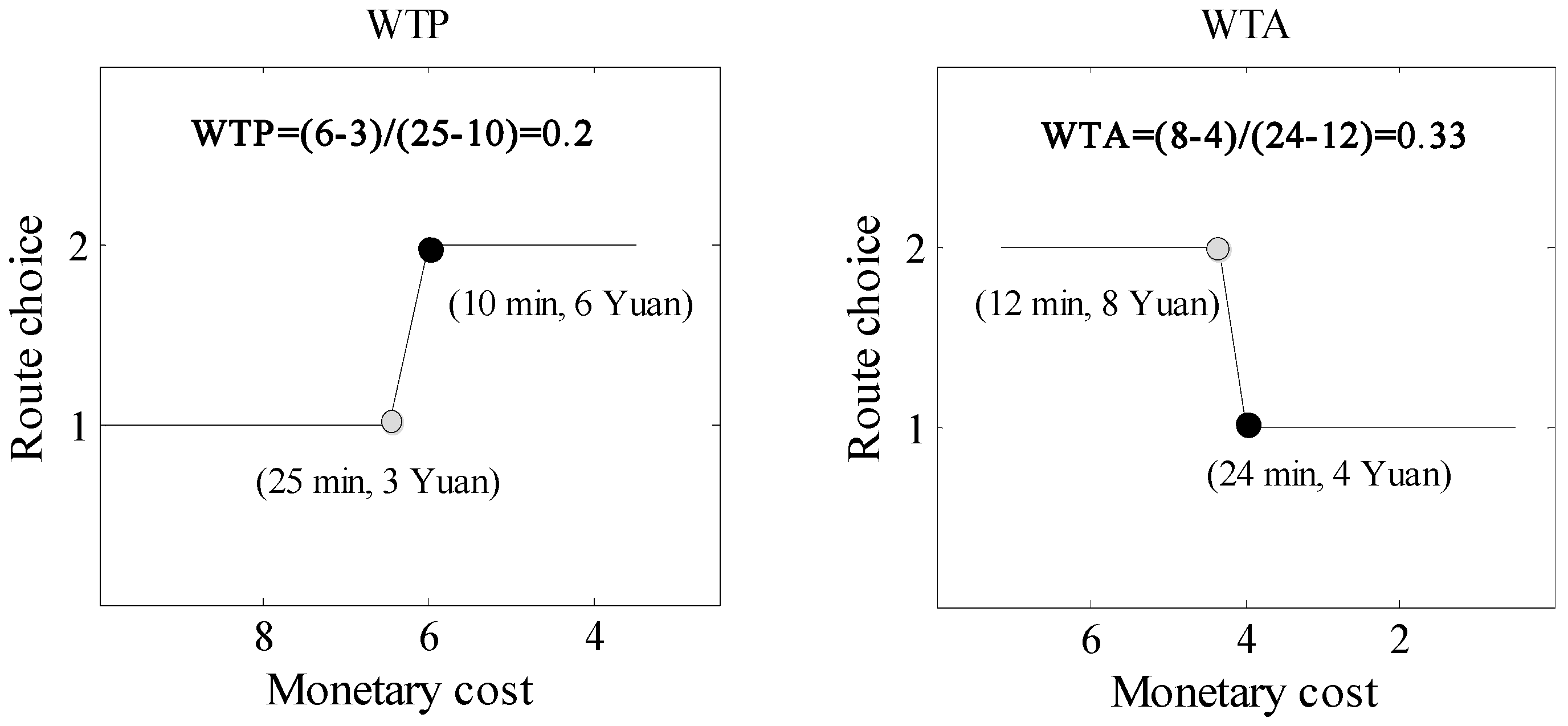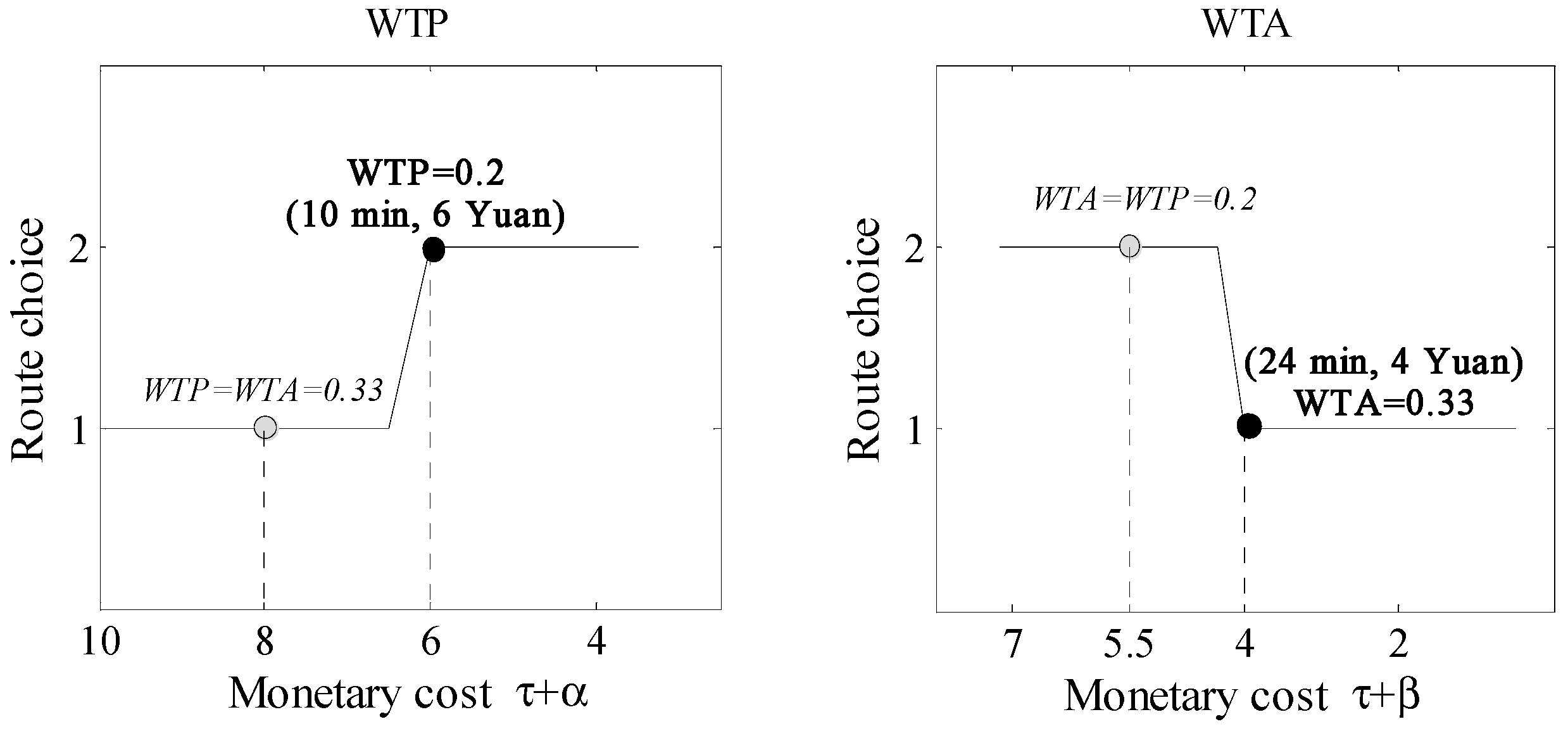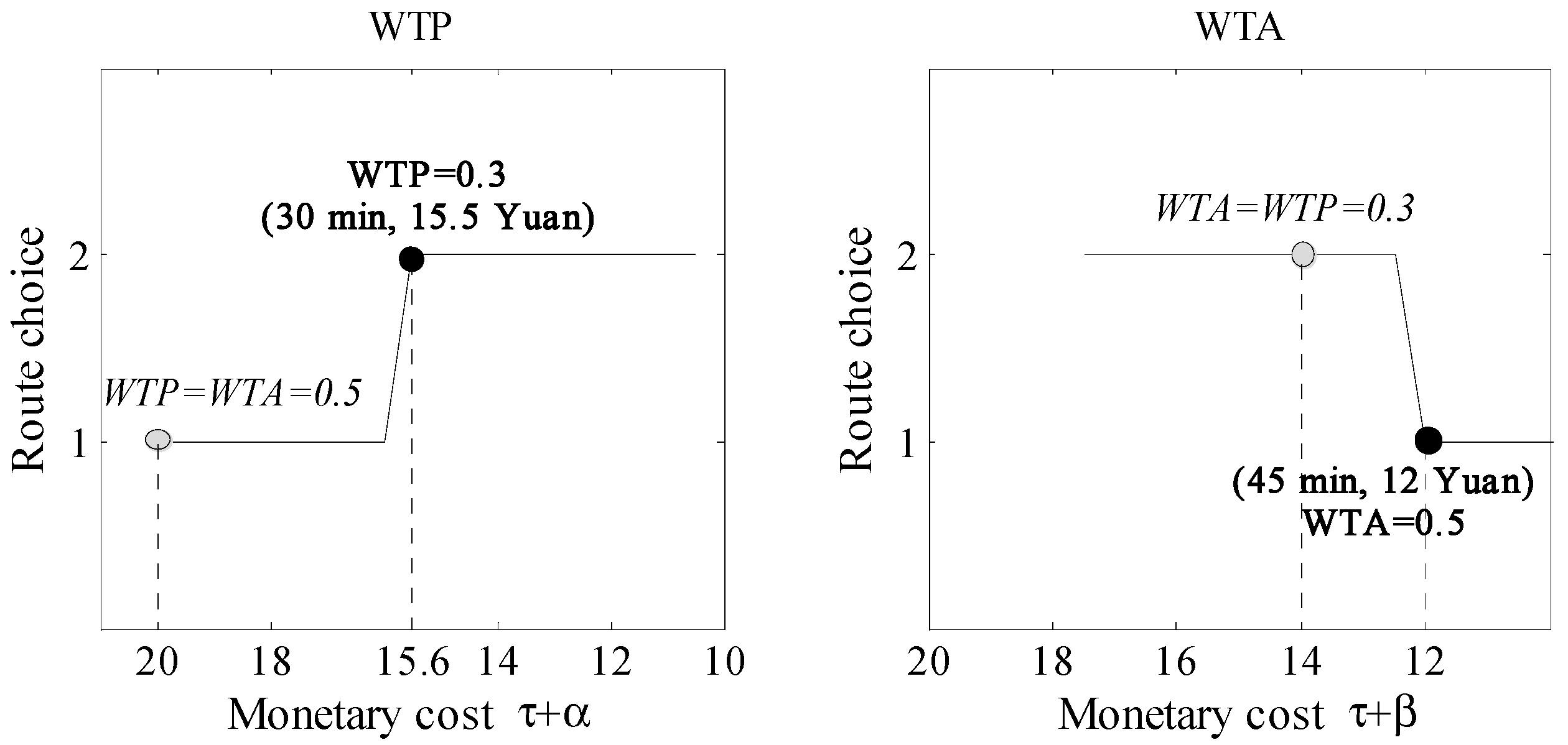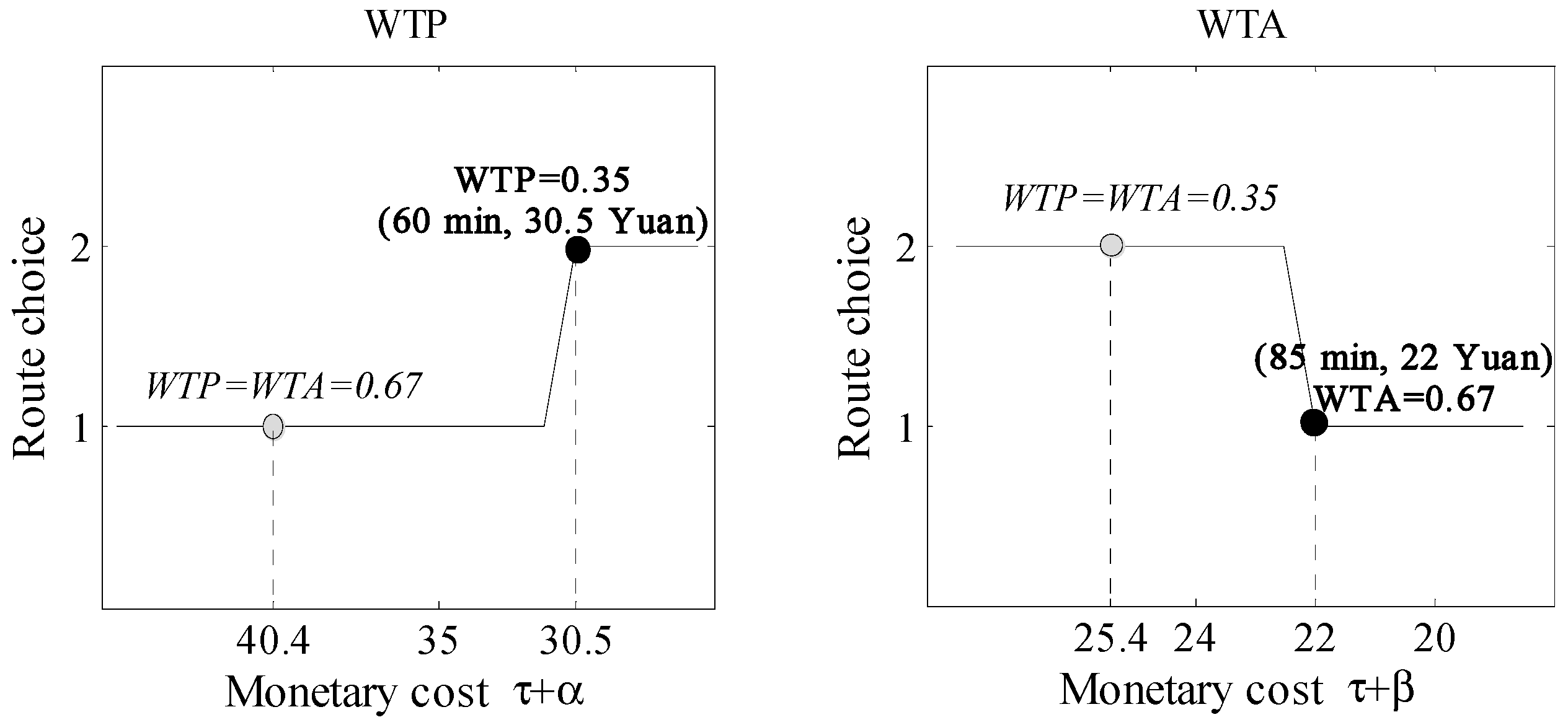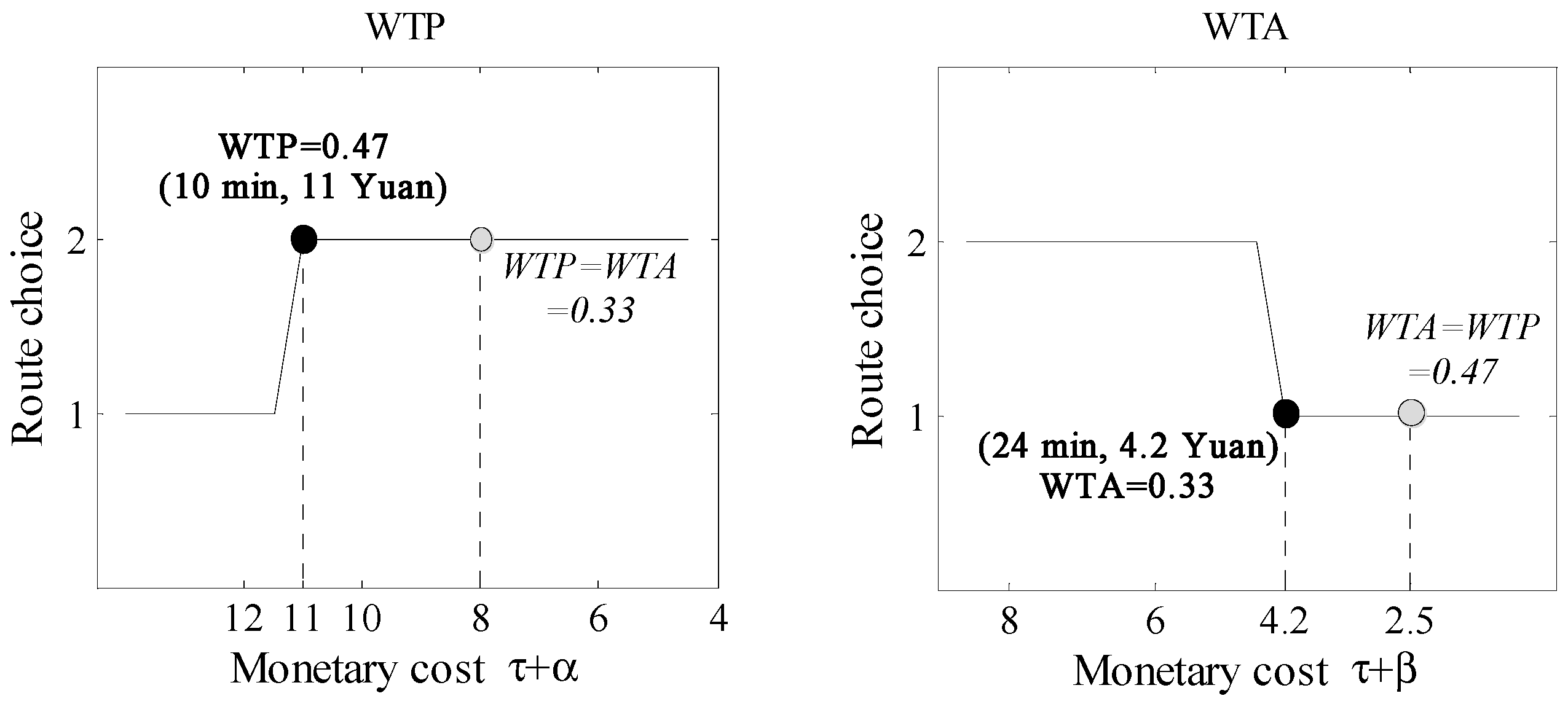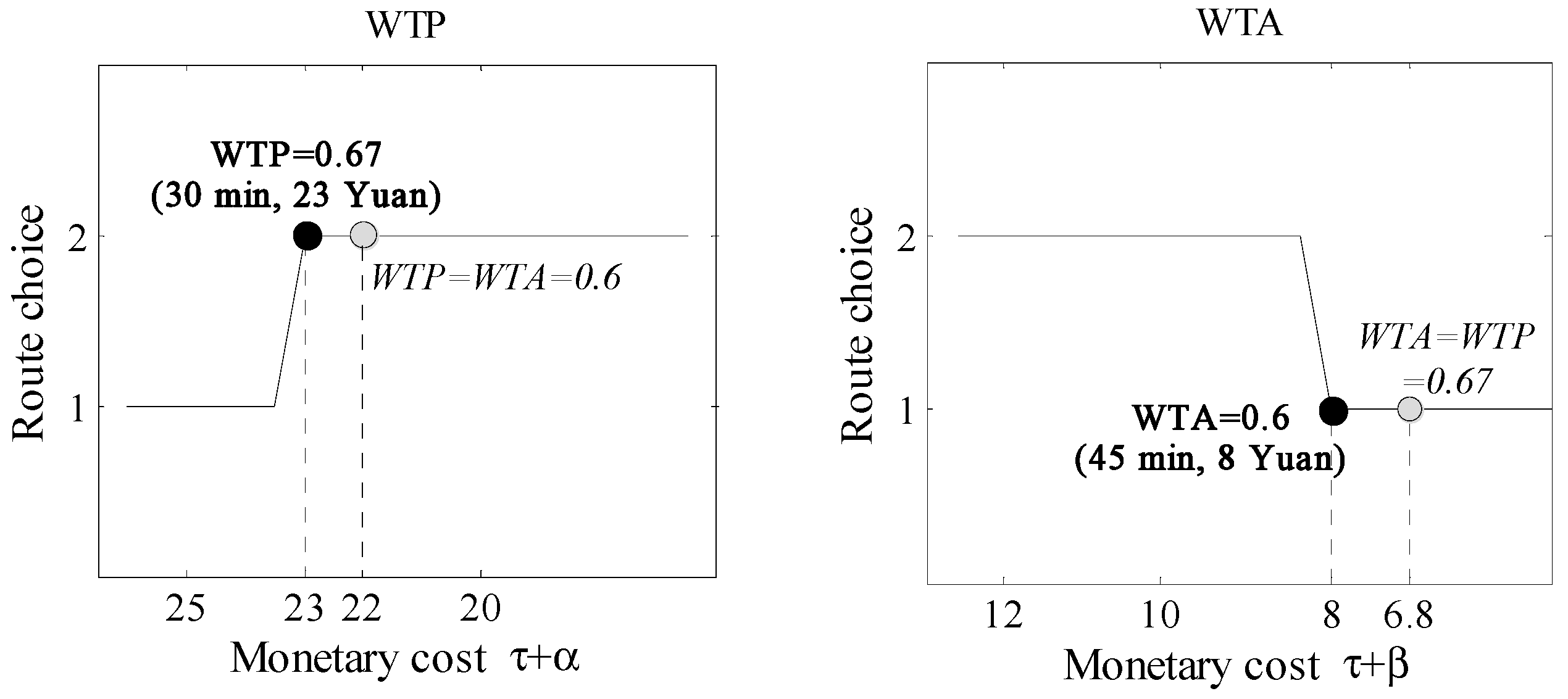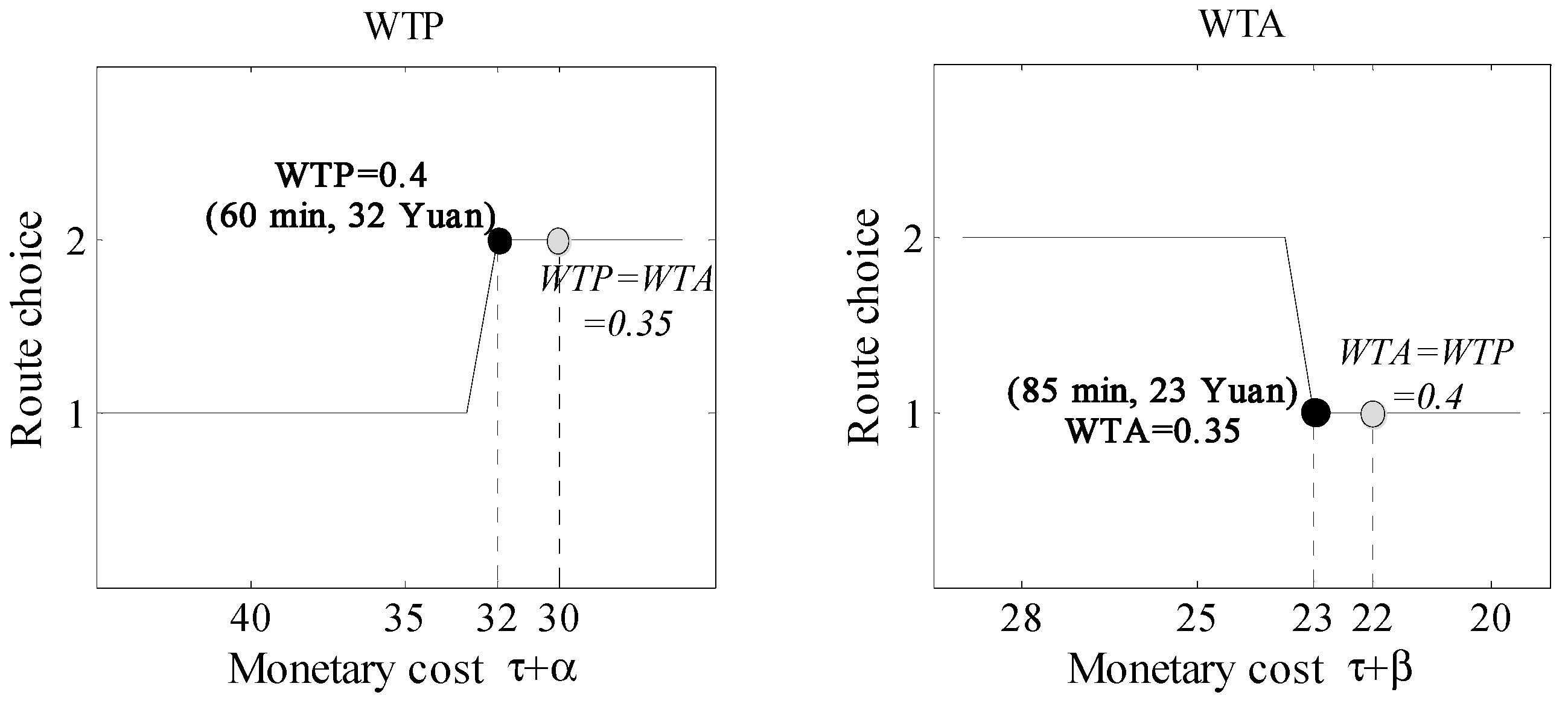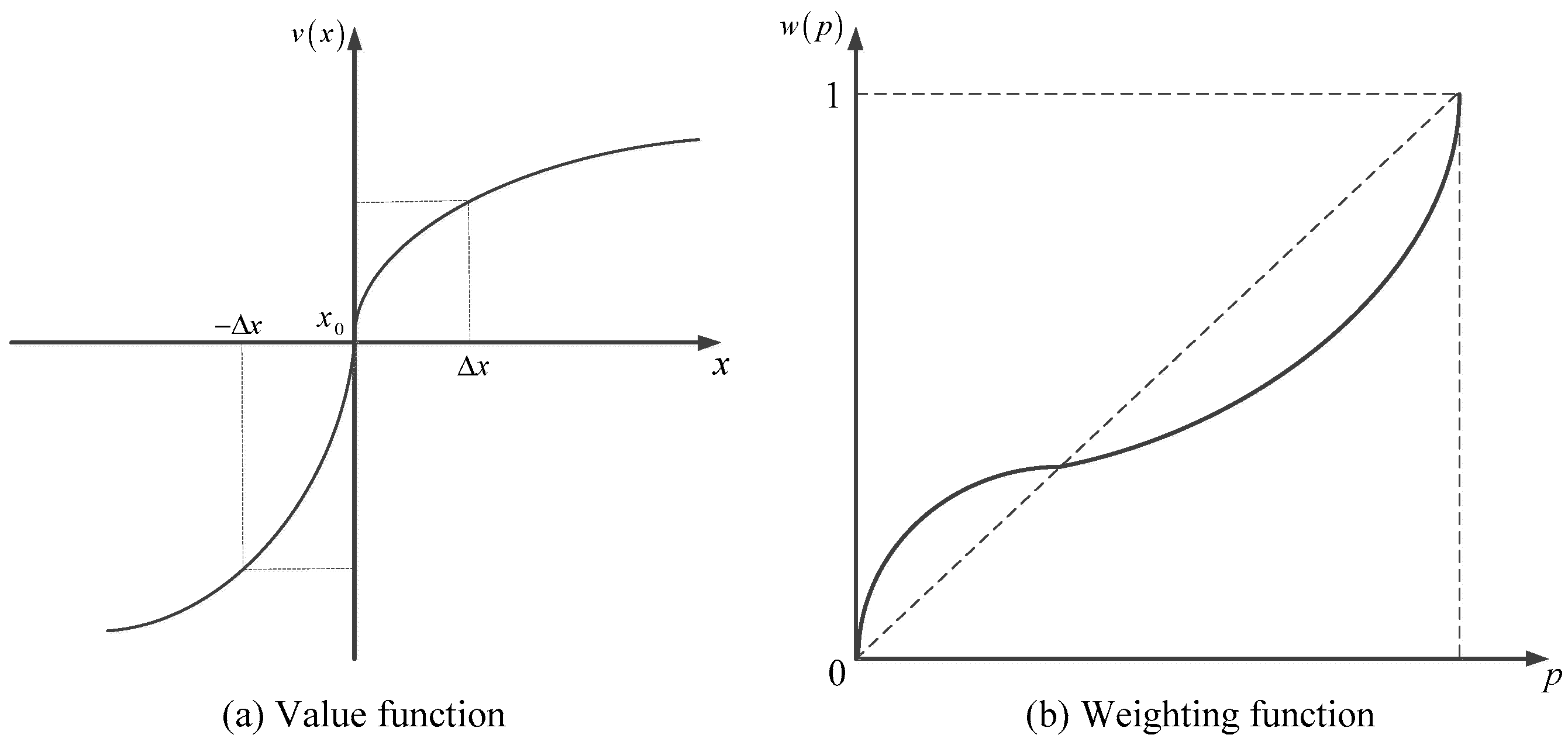1. Introduction
Travelers’ route choice behaviors have been researched for many years. Traditionally, it was assumed that all travelers would choose the routes with the shortest travel time [
1]. However, in reality, this assumption is very restrictive, because it ignores travelers’ cognitive limitations and intrinsic preferences [
2,
3,
4]. Moreover, many empirical studies have shown that travelers do not always choose the shortest routes [
5,
6,
7]. Simon [
8] indicates that people are boundedly rational, which means sometimes they prefer a satisfactory choice to an optimal one. Based on the concept of bounded rationality, Mahmassani and Chang [
9] introduced the concept of the indifference band to study travelers’ boundedly rational departure time choices. Lou et al. [
10] further encapsulated the indifference band into route choice modeling and proposed a boundedly rational route choice model, which addressed the limitation on travelers’ knowledge of traffic conditions and their capability of finding the best available routes. In their boundedly rational route choice model, travelers would not necessarily switch to the shortest route when the time (or cost) difference between the current route and the shortest one was lower than an inertia threshold. Zhao and Huang [
11] applied the concept of aspiration level to investigate travelers’ boundedly rational route choice behavior and found that travelers can only obtain the actual travel times of the chosen routes and are enabled to recognize the best routes.
The boundedly rational behavior in travel choice describes the facts that travelers will not always choose the routes with the shortest travel time. There are various causes raising such behavior, one of which is inertial choice. In fact, the term “inertia” was first mentioned in Newtonian physics, and it has been widely used to describe similar characteristics of human behavior. Inertial choice can be understood as the tendency to repeat previous choices [
12]. In the domain of behavioral decision, inertia was always employed to characterize the tendency for decision makers to choose options that maintain the status quo regardless of its outcome in a subsequent decision scenario, though the concise definitions were slightly different among the literature [
13,
14,
15,
16,
17,
18,
19].
In the area of travel behavior research, travelers’ inertia was defined as the tendency to stick to the alternative that they had previously chosen [
15,
20,
21,
22,
23,
24]. Many empirical studies provided support for the inertial route choice behavior [
7,
25,
26]. For example, Chorus and Dellaert [
15] thought that the wish to save cognitive resources could lead travelers to inertial choices; Site and Filippi [
27] explained that phenomenon in terms of “loss aversion”—the disadvantages of a move from the status quo are valued more heavily than the advantages. Besides saving cognition and avoiding loss aversion, other behavioral mechanisms which generate inertial behavior include the asymmetric preference [
4,
22], prevailing choice set [
28], habitual behavior [
29,
30], familiarity, prior decision [
21], risk aversion [
31], endowment effect [
32], and so on.
The asymmetric preference describes the phenomenon that travelers might feel different when they made a tradeoff between travel cost and travel time depending on whether they spend money to save time (willingness to pay, WTP) or they bear more time to receive money (willingness to accept, WTA) [
33]. While in the conventional study of the value of time, the substitutions between money and time are assumed to be constant. Various theoretical and empirical studies have been developed to examine the value of WTP and WTA as well as to estimate the gap between those two values [
34,
35,
36,
37,
38]. De Borger and Fosgerau [
35] adopted the status quo as the reference state to distinguish travelers’ judgment between gain and loss, and further examined the trade-off between money and time. Their empirical study confirmed the gap between WTP and WTA. However, De Borger and Fosgerau [
35] used “wrong choice” to describe travelers’ route choices in their research. In fact, travelers’ route choices were not “wrong”, their behavior was just coinciding with the inertial choice.
Therefore, based on the research of De Borger and Fosgerau [
35], Xu et al. [
4] proposed a status quo-dependent route choice model to handle the so called “wrong choice” behaviors from the view of inertial choice. In their proposed route choice model, travelers were assumed to “compare the travel cost to their status quo (travel cost of the currently used path) in deciding whether to switch to another alternative, and the underlying value of time is adaptive in the sense that it varies across different route choice contexts”. Xu et al. [
4] found that the status quo-dependent route choice model can explain the route choice inertia resulting from asymmetric preference. Moreover, the inertia is path-specific and can incorporate the scaling effect of travel cost on travelers’ route choices.
However, there was a lack of empirical study in Xu et al.’s [
4] research, thus they cannot clearly show that when travelers’ WTP is smaller than their WTA, or when travelers’ WTP is greater than their WTA, how travelers will make their route choices. In addition, how will the scaling effect of travel cost affect travelers’ asymmetric preference? This paper is an extended work of Xu et al.’s research aiming to provide more detailed support as an empirical study. A route choice experiment was conducted to investigate the impact of asymmetric preference on travelers’ inertial route choice. In the experiment, three different travel scenarios (short, middle, and long travel) were designed to collect participants’ route choice data. Then, based on the experimental data, the value of participants’ WTP and WTA were calculated and compared. According to the value of WTP and WTA, participants’ route choice behaviors were analyzed. Moreover, the parameters in Xu’s route choice model were also estimated.
The remainder of this paper is organized as follows.
Section 2 describes the status quo-dependent route choice model on how to handle travelers’ route choice behaviors that result from asymmetric preference.
Section 3 describes the route choice experiment as well as the data collection procedure.
Section 4 presents the calculation and analysis results of participants’ WTP and WTA and route choices in the experiment.
Section 5 presents the model parameters estimation. Finally,
Section 6 concludes the paper.
2. The Status Quo-Dependent Route Choice Model
For the convenience of readers, the symbols used in this section are summarized as follows:
| RW | the set of feasible routes for a given origin-destination (OD) pair w |
| the index for a route |
| the index for a route |
| the index for the travel time of route between OD pair |
| the index for the travel time of route between OD pair |
| the index for the monetary cost of route between OD pair |
| the index for the monetary cost of route between OD pair |
| the index for a pair of travel time and monetary cost of route between OD pair and |
Considering two arbitrary non-dominated routes
and
,
, without loss of generality, it is assumed that
and
. For the travelers on route
, the status quo-dependent travel utility by changing to path
is calculated as Equation (1).
where
is the status quo-dependent travel utility for the travelers on route
, with
representing the status quo and
the alternative. Parameter
is the travelers’ loss aversion coefficient of the time cost.
and
are the coefficients that unify time and monetary factors with travel utility. Thus, travelers on route
would suffer a smaller travel time, but they would obtain a larger cost in the aspect of monetary factors, and travelers would stick to route
if and only if the inequality
holds. Otherwise, the travelers on route
will change to route
. In addition,
holds if and only if
As indicated by Equations (1) and (2), travelers on route would not change to route if the potential improvement of monetary cost is not great enough (i.e., less than or equal to the right-hand-side value), and the coefficient in Equation (2) is equal to the travelers’ willingness to accept (WTA).
On the other hand, for the travelers on route
j the status quo-dependent travel utility by changing to route
, is calculated as Equation (3).
where
is the status quo-dependent travel utility for the travelers on route
, with
representing the status quo and
the alternative. Parameter
is the travelers’ loss aversion coefficient of the monetary cost. Travelers on route
would suffer a smaller monetary cost, but they would get a larger cost in the aspect of travel time and travelers would stick to route
if and only if the inequality
holds. Otherwise, travelers on route
will change to route
. In addition,
holds if and only if
As indicated by Equations (3) and (4), travelers on route would not change to route if the increase in monetary cost is greater than or equal to the right-hand-side value, and the coefficient in Equation (4) is equal to the travelers’ willingness to pay (WTP). Then, based on the above analysis, a route choice experiment will be conducted in the following section to verify travelers’ inertial route choices that resulted from asymmetric preference.
6. Conclusions
In this research, a route choice experiment was conducted to investigate travelers’ inertial route choice behaviors that resulted from asymmetric preference. Through data analysis, we can confirm that in the experiment participants used different measures to distinguish the value of time rather than constant substitution between money and travel time. Additionally, asymmetric preference significantly exists in participants’ route choices. Especially, for most participants, their WTP was smaller than WTA, and this makes them stick to the current route until one alternative route’s monetary cost is enough to tempt them to choose.
The value of this study lies in verifying travelers’ inertial route choices that resulted from asymmetric preference and estimating the values of parameters in Xu’s [
4] status quo-dependent route choice model. Moreover, by considering the asymmetric preference, we can explain why some travelers stick to a toll lane, even when there is an alternative road that is slightly better. However, there are some limitations in our experimental design. Firstly, we used the questionnaire survey data of 30 participants to estimate the values of parameters
and
. However, a behavioral experiment is needed to collect individuals’ route-choice data to estimate the values of parameters
and
. Secondly, as noted earlier, our experimental design was conducted with a lack of interaction between the participants’ choices. Thus, there is meaningful reason for designing a behavioral experiment, and to incorporate the asymmetric preference into traffic equilibrium modeling.
